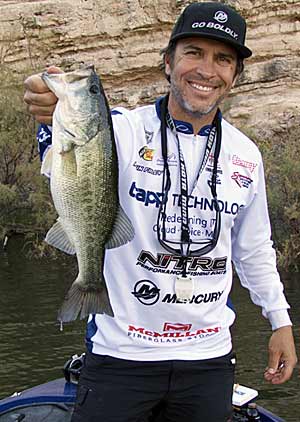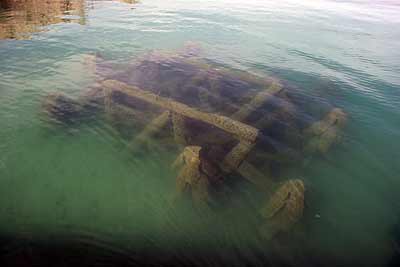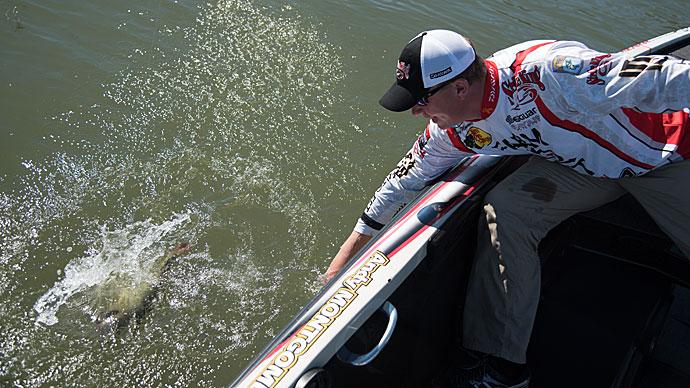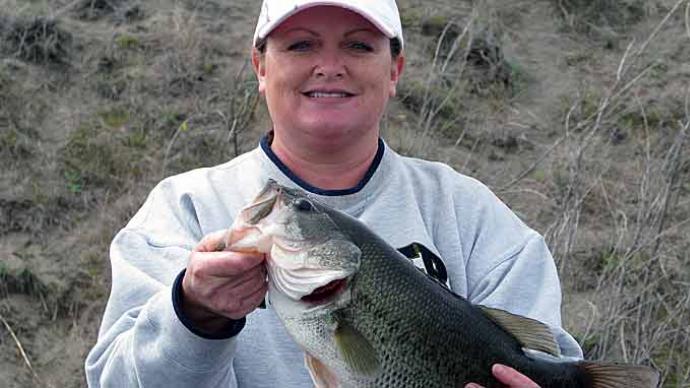
At the U.S. Open about four years ago, Arizona Nitro pro Kevin Finley found a Storm Arashi crankbait in the goodie bag he received at tournament HQ. Later, he went fishing at Lake Pleasant with a buddy, Taj White, and told him, “you tie on whatever you think I should throw – I’ve got a tournament coming at Pleasant.” Taj smashed them with the Arashi. That’s how he found out about the Arashi, and now he says it’s the best crankbait he’s ever used.
Finley says he’s never lost one – the hook hanger is perpendicular to the length of the lure, and that seems to help them not get snagged. “I’ve got some that look like you took a hammer to them,” he says, “they get beat up, but I always get them back.” Some of his Arashi baits are Silent Squares and some rattle. Kevin says he buys a bunch of them at a time. “If you buy a bunch of Silent ones,” he says, “seven or eight of them will be silent, and maybe one or two have little tiny knock inside.” Those are his absolute favorites. He says it’s a subtle, single knock, and you must shake it hard to hear. When he gets one like that, he marks it and says he dreads the day he ever loses one.
The #3 Arashi will run about three feet deep, and the #5 around five feet, but Kevin says on a long cast, you can get it to go six or even seven feet deep. “I love to have that #5 drag bottom in shallow water,” he says, “just totally scrubbing the bottom.” He’ll change the hooks four or five times a day if he’s throwing one because he says if you’re not dragging the bottom or touching something with it, it’s just not as good, and that goes for any crankbait, he says, not just the Arashi. The Strike King 5XD is another great crankbait at Pleasant, for instance.
Technique
Finley says you must get close to shore and throw the plug parallel to the bank. “If you’re not throwing parallel, don’t even use a crank,” Finley says. That’s what he does the vast majority of the time. Alternatively, he says you can use a really deep crankbait, throw it out, and then crank it uphill. This can be killer on a long shallow point or a little cut in the bank. Keep your eyes on the shoreline – when you see a small cut that runs out into the water, that cut continues under the surface.

You must throw that crankbait in deep clear water a long way. You must make long casts in clear water, no matter which bait you throw, particularly with this digging technique. In muddy water, you can make shorter casts so you can target areas between things like stumps and docks and such. Muddy water means you can pick your spots better, in other words.
Once the lure hits bottom, he cranks it super slow, barely moving it, but scrubbing the bottom. He says if you’re not getting bit, speed up a little. The number one rule is that you need to be hitting something. The number two rule is that you need to change your retrieve all the time – never reel right through. Change your cranking to make the retrieve erratic.
The stop-and-go hitting is because it makes the bait look real. Straight doesn’t look real, but if your bait is crashing into the bottom, rocks, stumps, and bouncing left and right, it looks real. Kevin says his lures go Bam!, right, Bam!, left. The Arashi hunts right and left all by itself, and that’s one of the things that makes it such a great bait, he says.
Kevin says that if he could get a crankbait to run thirty feet deep, he’d do it, but for the most part, about twenty feet deep is the limit to where he’ll dig a crank. Occasionally, while fun fishing, he’s thrown one way out and then used the trolling motor to get far away before cranking it back, but it takes too long. How much line you have out is directly relational to how deep the crankbait can go, so the longer you can cast, the deeper you can get your bait down there.
Grass
In the grass, a lipless rattling bait is almost always his choice – let them fall into the grass, then rip it out hard – he reels down and rips from 9:00 to 12:00. For ripping lipless baits in the grass, you need a stiffer rod because a soft rod won’t let you rip the hooks through the grass and the hooks will be constantly covered with the grass. He says Havasu has short, crispy grass that doesn’t come out of the water, and this ripping technique is excellent. For longer grass, you can reel it over the top and give it a good rip when it touches, but for the most part, he’d switch to a Chatterbait.

Specific Targets
At Lake Havasu on the Colorado River, there are a lot of man-made structures in the water, and that water is clear. You don’t want to run up on the cage or whatever, because that clear water means the fish can see you, too. Finley loves throwing crankbaits to the cages, and the magic number for him seems to be when the cage is in eleven to thirteen feet of water and has seven or eight feet over it. “You don’t want to hit the top. You want to bounce it off the sides of the cage,” Finley says, “and you want to stay as far away from it as you can.” He uses a Humminbird 360 to pinpoint those cages from a hundred feet away and cast incredibly accurately. He says the Garmin Livescope works for him too. This technique is so good that he’ll keep doing it even if he loses cranks to the cages. In one tournament, he lost nine crankbaits on a single cage, but he caught a six-pounder on the tenth cast. He was fishing his second-best cranks: the Bill Norman DD22, and they’re not expensive, so he doesn’t mind losing a few, especially on a tough tournament lake like Havasu.
Equipment
Finley uses a composite rod for crankin’ – part glass, part graphite. It’s a Bass Pro Shops rod and uses a Bass Pro Shops reel. Many guys have a hard time reeling slow, but he’s not one of them, so he uses a fast 7:1 or 8:1 BPS Platinum Signature Reel and cranks slowly once his bait hits bottom. As for knots, he doesn’t mess with success: he ties a Palomar on everything.
Line size makes a massive difference with this technique. For really deep cranking, he’ll use 8- to 10-pound-test fluorocarbon. The problem is that it frays incredibly quickly, so he will re-tie six or seven times an hour. Seriously. However, if the water is dirty, he’ll use 17-pound-test fluorocarbon line because he won’t be fishing so deep. Fish are always shallow in dirty water, he says. The stouter line means that if he gets snagged on something, he can pull it so hard the hooks straighten out, and he gets his bait back. The advantage of fluorocarbon is that it sinks – an advantage when digging cranks.
In the old days, the advice was glass and mono for cranks because mono stretches and glass bend, so you’re less likely to rip the crank away from the fish. But fluorocarbon also stretches, says Finley, the big difference being that mono continues to stretch, and fluorocarbon doesn’t. Fluorocarbon will stretch until you stretch it far, and then it won’t go back. He says the longer it’s on your reel, the less stretchy it is. Change your line more often, and you won’t have a problem.
Baits And Colors
The Arashi Silent Square is his number one bait for digging, but he also loves the Norman DD22s and the Strike King 5XD. The Backstabber Lures from Trophy Technology are great because they have a hook at the tail and on the back instead of the belly, so you get fewer hangups. He sticks to basic colors like crawfish, shad, and a few very bright ones, his favorite being FireTiger. The Castaic Lipless Stabber is a fantastic grass bait – it also has the hook on the back instead of the belly, and the Ghost Stabber is his favorite color. In dirty water, he chooses solid colors, even black, or he picks a bright color like chartreuse or red. He uses a translucent bait in clear water and a ghost bait in very clear. Also, he likes rattles in dirty water and silent baits for clear water, except for that unique subtle-knocking Arashi Silent Square baits he finds now and then.
Non-Boater Advice
You have to run the bank for this technique, and Kevin says this makes it challenging for the backseater. About all you can do, he says, is let the guy up front with you and give him the deeper side. It’s not ideal, but it’s better than nothing. As a backseater myself, I’d say if your boater is digging cranks, odds are you don’t have one that will run deep enough for you to do the same in deeper water. I’d pick up a heavy jig, like a one-tonner with a Yamamoto Hula Grub on it, and cast that out in front of the boat (on the non-bank side, of course). Depending on how fast your partner is moving the boat, you should be able to get it to the bottom and get a couple of good hops out of it before you have to re-cast. You could also try a heavy spinnerbait.
BassResource may receive a portion of revenues if you make a purchase using a link above.




